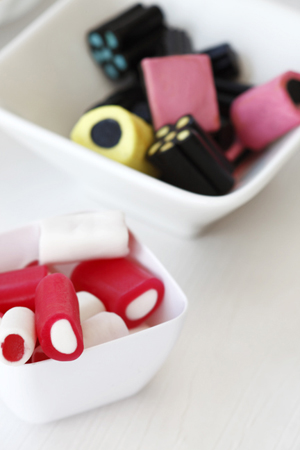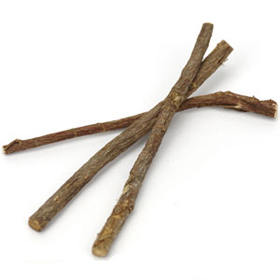 |

 |
At top, the mixed licorice selection known as Allsorts. At bottom, Strawberries & Cream licorice bites. Photo by Katharine Pollak | THE NIBBLE. |
| WHAT IT IS: Licorice from Australia, where they spell it “liquorice.” |
| WHY IT’S DIFFERENT: No corn syrup, no anise extract substituting for licorice extract. |
WHY WE LOVE IT: Robust flavors, a hearty chew and a perky beauty in the candy dish. |
| WHERE TO BUY IT: KookaburraLicorice.com. |
|
|
 |
 Licorice History Licorice History
Page 2: From Medicine To A Candy Favorite
This is Page 2 of a three-page article. Click on the black links below to visit other pages.
INDEX OF REVIEW
MORE TO DISCOVER
|
Licorice History
We know licorice as moderately firm, semi-firm gelled candy. But for thousands of years in ancient China, Egypt and Greece, it was a cure for stomach and respiratory ills, as well as a thirst remedy for travelers and soldiers.* It soothes irritated membranes and loosens congestion in the upper respiratory tract. It helps as an anti-inflammatory effects, with allergies and with the liver.
Use of licorice has been documented for 3,000 years. Ancient Egyptians created a drink from it. Large quantities of licorice root were found in the tomb of King Tut (1356 to 1339 B.C.E.) A popular version of the drink, called mai sus, is still enjoyed in Egypt. The troops of Alexander the Great and the Roman legions used licorice.
The Caesars advocated licorice as a health remedy. Some 1800 years later†, Napoleon Bonaparte chewed licorice for his ongoing digestive problems. Over time, his teeth turned black from the concentration of licorice juice. (You can chew on a piece of licorice root if you want the experience —just don’t make a habit of it.)
*According to Theophrastus, writing in the third century B.C.E., the Scythians were able to live for 12 days without water because they chewed on licorice root.
†The last Caesar was Caligula, who was assassinated in 41 C.E.
Licorice extract is made from the root of the licorice plant, Glycyrrhiza glabra. A member of the pea family that is native to southeastern Europe, licorice grows about four feet high with pretty bluish purple and white flowers that resemble sweet pea blossom. Although they have similar flavor notes, licorice is not related to the spices anise and star anise, the vegetable fennel or the spice tarragon. The relation is that all of these plants and spices contain anethole, an aromatic and sweet-tasting ether compound.
To make licorice extract or syrup, the dried root is boiled in water; then most of the water is evaporated. In addition to health remedies and confections, licorice is used in cooking to flavor broths, herbal teas, liqueur and soft drinks. The root can be chewed as a breath freshener. Before the widespread availability of affordable sugar, licorice was used as a sweetener (glycyrrhizin, a component of licorice, is 50 times sweeter than table sugar but also carries with it the strong licorice flavor).
|
|

Dried licorice root can be purchased by the pound at Southwest-Botanicals.com. |
Around 1500, licorice arrived in Europe with crusaders returning from the Holy Land. Monks continued the homeopathic uses, which spread across Europe during the Renaissance.
- Southern Europeans drank licorice tea, believed to be a “blood purifier.”
- Dominican friars introduced licorice to England. At some point, some manufacturer began to add honey to the licorice.
- A monastery in Pointer, England, in Yorkshire, became popular for its licorice discs, stamped with a seal (for decor and branding) and known as “Pointer cakes,” launched in 1614. As sugar became affordable, it was added in to Pointer cakes in 1760 and ratcheted up the popularity of licorice considerably. Pointer Cakes are still manufactured in Pointer, England and are sold internationally by Haribo.
- In the late Middle Ages, licorice pastilles cast in rough molds were widely available.
Licorice As A Confection
At some point, licorice, sweetened with honey or sugar, took on a new purpose: candy. While licorice extract continued to be used for medicinal purposes, its sweet chewiness was also made into treats.
- Extruded licorice candy (in tubes and ropes) is believed to have originated in Holland at the beginning of the seventeenth century.
- Licorice became one of the standard confections for candy producers, when the candy industry developed in the mid-1800s Industrial Revolution.
- Today licorice can be found in the shape of bites, drops, jujubes, laces (also called lariats, ropes and vines), pipes, tubes, twists, cats, coins, cows, pigs, reindeer, Scotties, sandwiches (part of an allsorts mix) and wheels.
- Krapelien & Holm, a Dutch manufacturer, makes bears, beagles, cars, cats, cones, farm animals, honeybees, lighthouses, thumbs, strawberries and other shapes.
|
|

Licorice Scotties are available at Amazon.com in black, red and chocolate licorice. Cat lovers can opt for the licorice cats. |
- Not enough for you? Check out licorice bridge mix, jelly beans and licorice mints (Altoids). Pastels are licorice centers with a hard candy shell (Good & Plenty is an example). Rockies are licorice tubes filled with a contrasting color/flavor of soft candy.
- Intensely-flavored pastilles (lozenges) are used as breath fresheners and to soothe sore throats, and are enjoyed as a confection by some people. (Sen-sen is a licorice and herb blend.)
- Like salted caramels? Check out salted licorice, the popular style in Germany and The Netherlands. Marshmallow-type licorice pillows, known as griotten, are also popular in Holland.
- You can also find sugar-free black licorice and red licorice sweetened with maltitol (a number of brands make sugar-free licorice, including Twizzlers).
- There is also gluten-free licorice, made with organic rice flour and rice starch instead of the wheat generally used to bind the licorice.
Now that you have an idea of the universe of licorice, continue to the next page to see one of our favorite brands.
Continue To Page 3: Kookaburra Licorice
Go To The Article Index Above
Sources:
HerbalLegacy.com
MadeHow.com
Do you have friends who would enjoy THE NIBBLE?
Click here to send them an invitation to sign up for their own copy. |
© Copyright 2004-2025 Lifestyle Direct, Inc. All rights
reserved. All information contained herein is subject to change at any time
without notice. All details must be directly confirmed with manufacturers, service
establishments and other third parties. The material in this e-zine may not
be reproduced, distributed, transmitted, cached, or otherwise used, except with
the prior written permission of Lifestyle Direct, Inc.
|
|

|
 |